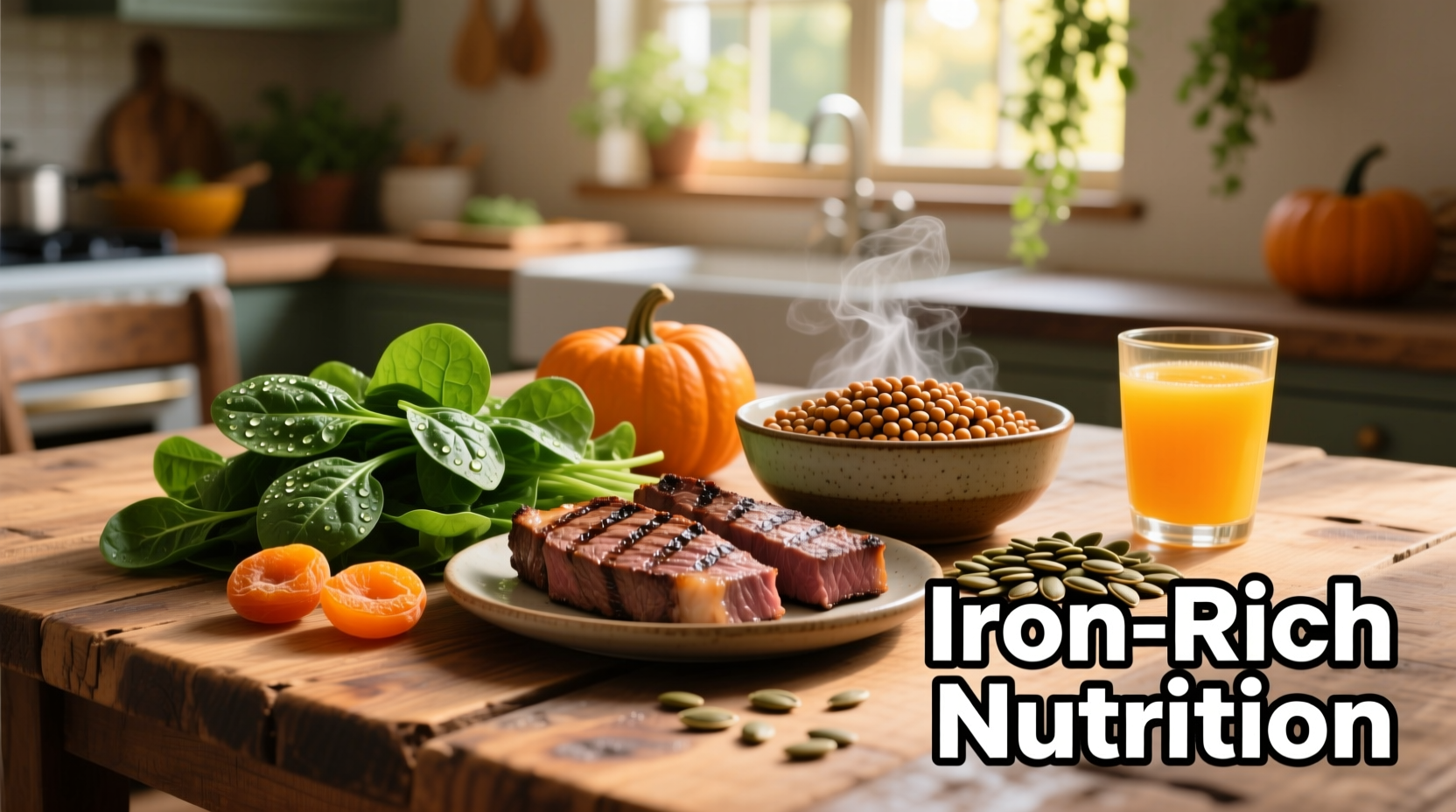The top iron-rich foods include red meat (beef, lamb), organ meats (liver), shellfish (oysters, clams), legumes (lentils, chickpeas), spinach, tofu, pumpkin seeds, and fortified cereals. Heme iron from animal sources is absorbed at 15-35% efficiency, while non-heme iron from plant sources is absorbed at 2-20% efficiency. Pairing vitamin C-rich foods with iron sources can boost absorption by up to 300%.
Why Your Body Needs Iron and How to Get Enough From Food
Iron deficiency affects over 1.2 billion people worldwide according to the World Health Organization. When you search for what food contain iron, you're likely looking for practical solutions to boost your intake without supplements. This guide delivers exactly that—science-backed food sources organized by absorption efficiency, with actionable tips you can implement immediately.
Understanding Iron Types: Why Source Matters
Not all dietary iron is created equal. Your body processes two distinct types:
- Heme iron (from animal sources): Absorbed at 15-35% efficiency
- Non-heme iron (from plant sources): Absorbed at 2-20% efficiency
Understanding this difference explains why someone eating spinach daily might still develop deficiency, while another person consuming moderate red meat maintains healthy levels. The National Institutes of Health confirms that heme iron absorption remains relatively consistent regardless of other dietary factors, while non-heme iron absorption fluctuates dramatically based on what you eat alongside it.

Top Iron Sources Ranked by Practical Value
When evaluating what food contain iron, consider both iron density and real-world absorption. This table combines USDA FoodData Central measurements with absorption research from the American Journal of Clinical Nutrition:
| Food (100g) | Iron (mg) | Absorption Rate | Practical Serving |
|---|---|---|---|
| Oysters | 6.9 | 18% | 6 oysters = 11mg iron |
| Beef liver | 6.5 | 22% | 3oz = 5.2mg iron |
| Lentils (cooked) | 3.3 | 5-12% | 1 cup = 6.6mg iron |
| Spinach (cooked) | 3.6 | 3-8% | 1 cup = 6.5mg iron |
| Pumpkin seeds | 8.8 | 4-10% | 1oz = 4.2mg iron |
Maximizing Iron Absorption: The Vitamin C Connection
Research from the NIH Office of Dietary Supplements shows that consuming 100mg of vitamin C (about one orange) with a meal can increase non-heme iron absorption by up to 300%. Practical pairings that work:
- Fortified cereal with strawberries
- Lentil soup with lemon squeeze
- Spinach salad with bell peppers
- Bean burrito with tomato salsa
Conversely, certain compounds inhibit absorption. The American Society of Hematology notes that calcium (in dairy), tannins (in tea), and phytates (in whole grains) can reduce iron uptake by 50-65% when consumed simultaneously. Space these items 1-2 hours apart from iron-rich meals for optimal results.
Daily Iron Requirements by Life Stage
Your iron needs change significantly based on biological factors. The National Academy of Medicine established these daily requirements:
- Men (19+ years): 8mg
- Women (19-50 years): 18mg (menstruation increases needs)
- Pregnant women: 27mg
- Vegans/vegetarians: 1.8x higher due to non-heme iron absorption rates
These recommendations evolved significantly over time. In the 1980s, the RDA for women was just 15mg. Modern research on iron metabolism prompted the 1998 increase to 18mg, reflecting better understanding of menstrual iron loss. This timeline shows how nutritional science continuously refines our understanding of dietary needs.
Recognizing Iron Deficiency Through Diet Patterns
While not a substitute for medical diagnosis, certain dietary patterns correlate strongly with deficiency risk:
- Exclusive plant-based diets without strategic vitamin C pairing
- Heavy tea/coffee consumption with meals
- Low meat intake combined with high dairy consumption
- Processed food diets lacking leafy greens and legumes
A 2022 study in Nutrients journal found that women following vegetarian diets who incorporated just two strategic iron-boosting practices (vitamin C pairing and avoiding inhibitors) maintained ferritin levels comparable to omnivores. This demonstrates how small dietary adjustments can yield significant improvements.
7-Day Iron-Rich Meal Plan Framework
Implement these principles with this flexible template. Each day provides 18-22mg iron:
- Breakfast: Fortified oatmeal with pumpkin seeds + orange slices
- Lunch: Lentil soup with kale + lemon dressing
- Dinner: Grass-fed beef stir-fry with broccoli and bell peppers
For plant-based adaptation: Substitute tempeh for beef, add 1 tbsp blackstrap molasses to oatmeal, and include dried apricots as snacks. The key is consistent vitamin C pairing at every meal.
When Food Isn't Enough: Recognizing Limitations
Dietary iron suffices for most people, but certain conditions require medical intervention:
- Heavy menstrual bleeding (losing >80ml blood/cycle)
- Gastrointestinal disorders affecting absorption
- Post-bariatric surgery patients
- Chronic blood loss conditions
If you experience persistent fatigue, shortness of breath, or pale skin despite optimizing your diet, consult a healthcare provider. The Centers for Disease Control considers iron deficiency anemia present when ferritin levels fall below 15 ng/mL, a diagnosis requiring professional evaluation.











 浙公网安备
33010002000092号
浙公网安备
33010002000092号 浙B2-20120091-4
浙B2-20120091-4